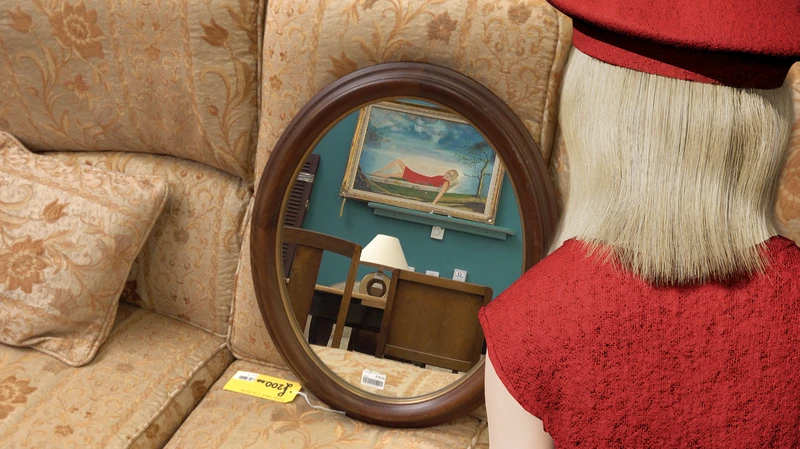Full of Days: Hermione Burton & Andy Holden, with music by Saint Etienne
19 Mar-21 May 2023
PV 19 Mar 2023, 2-6pm


Full of Days is artist Andy Holden’s personal response to another artist’s life. The exhibition is framed not as a monologue, but as a dialogue, giving the late Hermione Burton a voice, a platform and an audience.
In 2017 Holden came across a curious group of eclectic paintings in a charity shop in his hometown of Bedford. The bold signature declared the author’s name: Hermione. Accompanying the artworks were framed photographs of the artist and a self-published autobiography, Hermione Burton: A Journey Through the Paintings, a thin booklet which described the major events of the artist’s life, her creative evolution and her ongoing struggles with ill health.
Sensing instinctively that this was a meaningful body of work with a personal relevance, Holdenpurchased the entire group of artworks. The paintings appeared to him as if they were frames from a film. If they were not kept together, the artist’s story would be lost forever.
Hermione Burton’s paintings read as both therapy and diary. They describe the past and commemorate the present. The artist frequently paints herself, becoming the primary audience for her own experience. Titles are often celebratory, yet the disjunctive compositions and melancholic shimmering of the paintings allude to a different story.
Critically, the images which chronicle Hermione’s journey are both interior and exterior. They reveal a sense of urgency - a biographical record her life before it is too late. She re-imagines memories and even anticipates a future audience. A key painting shows a fictional salon-hang of her opus, some works known, others lost, some perhaps invented. This picture, Hermione’s ArtExhibition, provides the starting point for Holden’s own exhibition.
At the centre of the project is Holden’s forty-minute film, Kingdom of the Sick, titled in reference to Susan Sontag’s 1978 essay Illness as Metaphor. Alternating between documentary, biography and fiction, Kingdom of the Sick uses digital technology to re-animate Hermione as narrator of her own history, guiding the viewer through her life and work with language excerpted from her unpublished autobiography.
Hermione’s voice and facial expressions have a strange otherworldly quality. The role is provided through motion capture by Sarah Cracknell, vocalist of the band Saint Etienne. Saint Etienne also provide the film’s original soundtrack, lending the project a sense of reflective, ethereal drama.
Hermione’s narrative is intercut with interviews with people who appear in her paintings, tracked down by Holden from names recorded on the reverse of several canvases. Through these interviews, as much as through Holden’s familiar and inquiring voiceover, a more expansive understanding of the artist begins to emerge.
Holden’s film then shifts from an interpretation of Hermione’s art into his own ongoing enquiries as to how we experience time. When disrupted by sickness or grief, our temporal senses are ruptured; for Holden, this becomes the unacknowledged subject of Hermione’spaintings. Few of these works are dated and perhaps they can be read as depictions of the experience of living outside of time’s flow, and reveal, in Holden’s words, ‘the time of the sick’.
Holden’s exegesis acknowledges the significance of perspectival shifts in Hermione’scomposition as choices which articulate her particular worldview, rather than formal idiosyncrasies, technical limitations or the vernacular of self-taught art. Hermione’s paintings are interpreted by Holden as the possibility of painting to describe a world in which time no longer moves - an enunciation of non-linear time, which the sequential unfolding of language works to obscure.
Through rescuing and retelling her story, Holden asks how much a person can be understood by interpreting the work they left behind, and positions art as a tool which can express an interiority that cannot otherwise be voiced during a lifetime.
Illness is the night-side of life, a more onerous citizenship. Everyone who is born holds dual citizenship, in the kingdom of the well and in the kingdom of the sick.
—Susan Sontag, 1978